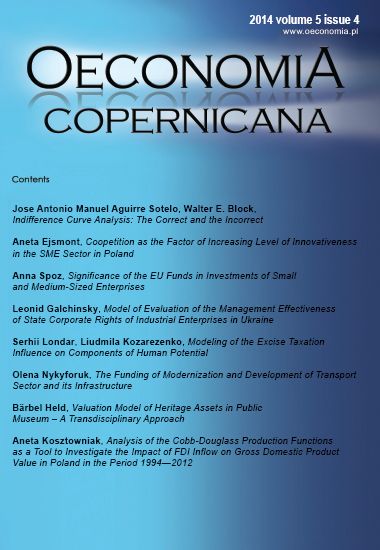Valuation Model of Heritage Assets in a Public Museum ? A Transdisciplinary Approach
DOI:
https://doi.org/10.12775/OeC.2014.031Keywords:
heritage assets, museum, strategic planning, portfolio management, valuation modelAbstract
The new public management account requires an opening balance sheet which needs to depict all assets and capital. This is also true for heritage assets in public museums. However, there exists neither in Germany nor generally an accepted international valuation approach, while at the same time there is a cut for public budget. As a result, the communes must decide on which area of responsibility to allocate financial resources and in what amount. With regard to museums, it means to define the tasks according to the strategic target planning, and to consequently derive the portfolio of the museum. The following article aims at designing a model for the challenge described. This is based on a trans-disciplinary approach and builds upon an extensive literature study, qualitative expert interviews and an evaluation in three existing museums. The focus is on the question of how art and cultural objects can be valued for accounting purposes. It is important to value the assets not only according to economic criteria but, due to the special task of museums, to also assess assets after their social benefits.
Downloads
References
Berit, A., Mussari, R., & Jones, R. (2011). The Diversity of accrual policies in local government financial reporting: An examination of infrastructure, Art and Heritage Assets in Germany, Italy and the UK. Financial Accountability & Management, 27(2).
Candela, G., & Scorcu, A. E. (1997). A price index for art market auctions. Journal of Cultural Economics, 21(3). DOI10.1023/A:1007442014954.
Carnegie G. D., & Wolnizer, P. W. (1995). The Financial Value Of Cultural, Heritage And Scientific Collections: An Accounting Fiction. Australian Accounting Review. 5(9). DOI: 10.1111/j.1835-2561.1995.tb00164.x.
Chanel, O., Gérard V., & Ginsburgh, V. (1996). The relevance of hedonic price indices. Journal of Cultural Economics, 20(1).
Chanel, O., Varet, L., André, G., & Vincent, S. (1996a). Auction theory and practice: Evidence from the market for jewelry. In: V. Ginsburgh & P. M. Menger (Eds.). Economics of the Arts. Selected Essays. North-Holland, Amsterdam.
Chiaravalloti, F. (2014). Performance Evaluation in the Arts and Cultural Sector: A Story of Accounting at Its Margins. Journal of Arts Management, Law, and Society, 44(2).
Dillerup, R., Göttert, S., & Gedeon, C. (2005). Wissensbilanz und Controlling von Strukturkapital ? Fallstudie des mittelständischen Maschinenbau Unternehmens SiCo GmbH & Co. KG. ZfCM Controlling & Management. 3.
Dillerup, R., & Hannss, S. (2006). Bewertung immateriellen Vermögens ? Steuerung, Bewertung und eine Frage strategischer Unternehmensführung. Horizonte 29 December.
Frey, N. (2011). Betriebswirtschaftliche Kunstbewertung, Gabler: Springer.
Glanz, S. (2011). Zur Bilanzierung der Kultur und Naturgüter (Heritage Assets). IRZ, 1.
Gottschalk, I. (2006). Kulturökonomik, VS Verlag für Sozialwissenschaften. Wiesbaden.
Heid, K., & Ruediger J. (Eds) (2003). Transfer: Kunst Wirtschaft Wissenschaft. Baden-Baden.
Held, B. (2009). Bewertungspraxis und Substanzerhalt von Kunst- und Kulturgütern. Controller-Magazin. Haufe-Verlag.
Held, B. (2011). Bewertungsmodell gemeinnütziger Heritage Assets ? Diskussionspapier. Schriftenreihe New Public Management. Steinbeis-Edition.
Heuer, C.l-H. (2008). Die Bewertung von Kunstgegenständen. Neue Juristische Wochenschrift. 11/08.
ICOM Schweiz, ICOM Deutschland and ICOM Österreich (Ed.) (2010). Ethische Richtlinien für Museen von ICOM.
IFAC (2001). Retrieved from http://www.ifac.org/sites/default/files/publicatio ns/files/A26%20IPSAS_17.pdf (1.09.2013).
Jörissen, J., Kopfmüller, J., Brandl, V. & Paetau, M. (1999). Ein integratives Konzept nachhaltiger Entwicklung Karlsruhe: Forschungszentrum Karlsruhe GmbH, 1999 Technik und Umwelt, Wissenschaftliche Berichte FZKA 6393.
Municipal Financial Management Act NRW-NKFG NRW (2004). Retrieved from http://www.mik.nrw.de (1.09.2013).
Mayring, P. (2010). Qualitative Inhaltsanalyse: Grundlagen und Techniken, 11. Auflage, Beltz.
Renneboog, L., & Spaenjers, C. (2009). Buying beauty: On Prices and returns in the art market, Department of Finance, CentER, Tilburg University.
Review Policy-Bewert (2009). Retrieved from http://www.doppik-kom.brandenburg.de/cms/detail.php/bb1.c. 191223.de (1.10.2012).
Ritchel, K. (2008). Vom Wert der Sammlungen-Museumsgüter in der Bilanz. Museumskunde Band. 73 1/08.
Scholz, C. (2005). Die Saarbrücker Formel-Was Ihre Belegschaft wert ist. Personal manager. 2.
Stein B. (2003). Konzeption eines mehrdimensionalen Kennzahlensystems als Instrument der Erfolgssteuerung in der öffentlichen Verwaltung ? dargestellt am Beispiel der Hochschulen, (Dissertation), ProBusiness.
Stein, B., & Franke, R. (2005). Bewertung von Kunst- und Kulturgütern in kommunalen Bilanzen. Der Gemeindehaushalt.
Snowball, J. D. (2008). Measuring the Value of Culture. Berlin: Springer-Verlag.
Spangenberg, J. H. (2003). Soziale Nachhaltigkeit. Eine integrierte Perspektive für Deutschland. UTOPIE kreativ I. 153/154.
Throsby, D. (2001). Economics and culture. Cambridge: Cambridge University Press.
Throsby, D. (2003). Determining the value of cultural goods. How much (or how little) does contingent valuation tell us?. Journal of Cultural Economics. 27.
Throsby, D. (2007). Regional Aspects of Heritage Economics: Analytical and Policy Issues. Australasian Journal of Regional Studies. 13(1).
Throsby, D. (2012). Heritage economics: a conceptual framework. In: G. Licciardi & R. Amirtahmasebi (Eds.). The Economics of Uniqueness: Investing in Historic City Cores and Cultural Heritage Assets for Sustainable Development. Washinington DC: The World Bank.
Trossen, N., & Bockemühl, M. (2003). Ein Bericht über das Forschungsprojekt "Wirtschaftskultur durch Kunst". In: K. Heid & J. Ruediger (Eds.). Transfer. Baden-Baden: Kunst-WirtschaftWissenschaft Sic.
Vorstand des Sächsischen Museumsbundes (2009). Wie viel ist die Sixtinische Madonna wert? Eine zweite Stellungnahme des Vorstandes des Sächsischen Museumsbundes e.V. zur Bilanzierung von Museumsgut im Rahmen der Doppik vom 3. Dezember.
Turskis, Z., Zavadskas, E. K., & Vladislavas K. (2013). A model based on ARAS-G and AHP methods for multiple criteria prioritizing of heritage value. International Journal of Information Technology & Decision Making, 12(1).






